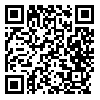شمارۀ جدید فصلنامه (پاییز1404) منتشر شد
Volume 15, Issue 4 (12-2024)
Social Problems of Iran 2024, 15(4): 195-230 |
Back to browse issues page
Download citation:
BibTeX | RIS | EndNote | Medlars | ProCite | Reference Manager | RefWorks
Send citation to:



BibTeX | RIS | EndNote | Medlars | ProCite | Reference Manager | RefWorks
Send citation to:
Zokaei M S, abedindo F. (2024). Couples' Interactions and Withdrawal of Women from Sexual Commitment: A study in Tehran. Social Problems of Iran. 15(4), 195-230. doi:10.61186/jspi.15.4.6
URL: http://jspi.khu.ac.ir/article-1-3743-en.html
URL: http://jspi.khu.ac.ir/article-1-3743-en.html
1- Professor in Sociology & Cultural Studies, Faculty of Social Sciences, Allameh Tabataba'i University, Tehran, Iran , saeed.zokaei@gmail.com
2- Ph. D. Student of Social Problems of Iran, Azad University Research Science Unit, Tehran, Iran
2- Ph. D. Student of Social Problems of Iran, Azad University Research Science Unit, Tehran, Iran
Abstract: (979 Views)
Carelessness and lack of commitment in marital relations is one of the important causes of disruption and damage in the family center. This research, with an interpretive perspective, seeks to analyze the contexts and processes on the basis of which critical marital relationships end in the withdrawal of married women from sexual commitment. The theme analysis of the interviews conducted with eleven women with the experience of infidelity in marital sex in Tehran showed: Deprivation of choice (child marriage), domestic violence (verbal, physical and sexual, depriving the necessities of life), The quality of sex (different sexual orientation, deprivation of sex, husband's addiction to masturbation),Avoid playing male roles(drug addiction, long-term financial crises),Reaction to the husband's behavior (restoring a sense of worth, reciprocal response to the husband's betrayal) In three overarching themes (Ownership of life and women's bodies, patriarchal culture, and women's efforts for more effective agency) it is of the most important areas leading women to abandon marital fidelity. Women's departure from this commitment is mainly related to unstable family conditions and various types of violence from the husband.
Keywords: Marital Commitment, Sexual Relationship, Extramarital Relationship, Marital Relationship, Betrayal, Sexual Commitment
Type of Article: Original Research |
Subject:
Women
Received: 2024/09/30 | Accepted: 2024/12/7 | Published: 2025/01/31
Received: 2024/09/30 | Accepted: 2024/12/7 | Published: 2025/01/31
References
1. Achen, S., Atekyereza, P., & Rwabukwali, C. B. (2021). The role of culture in influencing sexual and reproductive health of pastoral adolescent girls in Karamoja sub-region in Uganda. Pastoralism, 11(25).
2. Arends, R. I. (1998). Resource handbook. Learning to teach. McGraw-Hill.
3. Bay-Cheng, L. Y. (2015). The Agency Line: A Neoliberal Metric for Appraising Young Women’s Sexuality. Sex Roles, 73, 279–291. https://doi.org/10.1007/s11199-015-0452-6
4. Dewey, J. (1986, September). Experience and education, The educational forum (Vol. 50, No. 3, pp. 241-252). Taylor & Francis Group.
5. Connell, R. W. (1987). Gender and Power: Society, the Person, and Sexual Politics. Stanford: Stanford University Press. https://psycnet.apa.org/record/1988-97032-000
6. Elliott, S. N., Kratochwill, C. R., Cook, J. L., & Travers, J. F. (2000). Educational psychology: effective teaching effective learning. Boston: McCraw Hill.
7. Fraser, N. (1990). Unruly Practices: Power, Discourse and Gender in Contemporary Social Theory. Minneapolis: University of Minnesota Press.
8. Fredrickson, B. L., & Roberts, T.-A. (1997). Objectification theory: Toward understanding women’s lived experiences and mental health risks. Psychology of Women Quarterly, 21(2), 173–206. https://doi.org/10.1111/j.1471-6402.1997.tb00108.x
9. Giddens, A. (1991). Modernity and self-identity, Cambridge. Polity, 109.
10. Giddens, A. (1992). The Transformation of Intimacy: Sexuality, Love, and Eroticism in Modern Societies. Stanford: Stanford University Press.
11. Hitlin, S., & Elder, G. H., Jr. (2007). Time, Self, and the Curiously Abstract Concept of Agency. Sociological Theory, 25(2), 170-191. https://doi.org/10.1111/j.1467-9558.2007.00303.x
12. hooks, b. (1984). Feminist Theory: From Margin to Center. Boston: South End Press.
13. Klein, V., Becker, I., & Štulhofer, A. (2018). Parenting, Communication about Sexuality, and the Development of Adolescent Womens’ Sexual Agency: A Longitudinal Assessment. Journal of Youth and Adolescence, 47(8), 1486–1498. https://doi.org/10.1007/s10964-018-0866-3
14. Litzenberger, B. W., & Buttenheim, M. C. (1998). Sexual orientation and family development: Introduction. American Journal of Orthopsychiatry, 68(3), 344–351. https://doi.org/10.1037/h0080340
15. McLeod, S. (2019). Constructivism as a theory for teaching and learning. Simply Psychology. https://www.simply psychology.org/constructivism.html
16. Meijerink-Bosman, M., Back, M., Geukes, K., Leenders, R., & Mulder, J. (2022). Discovering trends of social interaction behavior over time: An introduction to relational event modeling. Behavior Research Methods, 55, 997–1023. https://doi.org/10.3758/s13428-022-01777-4
17. Mullenhauer, W. A. (2011, April 15). Female Sexual Dysfunction: History, Criticisms, and New Directions. Retrieved from eScholarship.org, https://escholarship.org/uc/item/8jh824n
18. Omoeva, C., & Hatch, R. (2022). Teenaged, married, and out of school: Effects of early marriage and childbirth on school exit in Eastern Africa. PROSPECTS, 52(4), 299-324.
19. Peplau, L. A., Spalding, L. R., Conley, T. D., & Veniegas, R. C. (1999). The Development of Sexual Orientation in Women. Annual Review of Sex Research, 10, 70-99. https://www.researchgate.net/publication/12424471_The_development of sexual orientation in women, Annual Review of Sex Research, 070-99
20. Phillips, D. C. (1995). The good, the bad, and the ugly: The many faces of constructivism. Educational researcher, 24(7), 5-12.
21. Rauf, B., Saleem, N., Clawson, R., Sanghera, M., & Marston, G. (2018). Forced marriage: implications for mental health and intellectual disability services. Published online by Cambridge University Press.
22. Turner, M. J. (2016). Rational emotive behavior therapy (REBT), irrational and rational beliefs. In N. J. Smelser & P. B. Baltes (Eds.), International encyclopedia of the social & behavioral sciences (Vol. 21, pp. 14409-14413). Elsevier. https://doi.org/10.1016/B0-08-043076-7/01767-6
23. Umberson, D., Thomeer, M. B., & Lodge, A. C. (2015). Intimacy and emotion work in lesbian, gay, and heterosexual relationships. Journal of Marriage and Family, 77(2), 542–556. doi: 10.1111/jomf.12178
24. Vygotsky, L. S., & Cole, M. (1978). Mind in society: Development of higher psychological processes. Harvard university press.
25. Walby, S. (1990). Theorizing Patriarchy. Oxford: Blackwell. https://doi.org/10.1177/0038038589023002004
26. Waylen, G. (1998). The Politics of Gender: A Feminist Approach to Global Politics. London: Routledge.
27. Afshari Kashanian, Omid, Zehrakar, Kianoush, Mohsenzadeh, Farshad & Tajik Esmaeili, Azizollah (2019). Identification of Predisposing Factors of Marital Infidelity in Women. Counseling Research, 18(71), 121-154. http://dx.doi.org/10.29252/jcr.18.71.121 (in Persian)
28. Ali Rezanejhad, Soheila (2016). Transformations in Feminine Experience of Love and Marriage: An Ethnographic Study on Urban Educated Employed Women in Tehran. Anthropology Letter, 14(25), 115-144. https://faslname.msy.gov.ir/article_236.html?lang=en (in Persian)
29. Arjmandi, Majid (2013). Domestic Violence in Iran; From Statistics and Figures to Intervention and Prevention Methods. Tabnak. 08 January 2014. https://www.tabnak.ir/fa/news/370031 (in Persian)
30. Azkia, Mostafa & Darban Astaneh, Alireza (2018). Practical Research Methods. Tehran: Keyhan Publishing. (in Persian)
31. - Chopani, Mousa, Fatehizadeh, Maryam, Asenjarani, Faramarz & de Castro Coria, Alberto Mario (2021). Existential Phenomena in Men's Marital Infidelity. Family Research, 17(3), 483-513. https://jfr.sbu.ac.ir/article_101861.html (in Persian)
32. Hakim, Catherine (2012). Sexual Capital and its Role in Power Relations in Society. Translated by Zhila Sarabi, London: Digital Edition. (in Persian)
33. Hedayati, Mahrnosh & Beigi, Sara (2016). Determining the Relationship between Attachment Styles and Marital Satisfaction with Sexual Function Index in Women. Women's Research Journal, 7(16), 127-141. (in Persian)
34. Khaledian, Mohammad, Shahmoradi, Somayeh & Madani, Yaser (2023). Explaining the Process of Forming Marital Infidelity in Women with Drug-Dependent Spouses. Addiction Research Quarterly, 17(67), 197-228. http://dx.doi.org/10.52547/etiadpajohi.17.67.197 (in Persian)
35. Khosravi, Zahra & Abbaszadeh, Saeedeh (2015). Examination of Gender-Based Interpretive and Semantic Processes in Ethical Action Selection. Women's Psychological and Social Studies (Formerly Women's Studies), 13(1), 7-32. https://doaj.org/article/273dba67ec2c4dbfbdfac6cf5f900867
(in Persian)
36. Maliheh El Zakirini, Saeed, Kharazi Afra, Mohammad & Esmaili Rador, Farahnaz (2014). Examination of Identity Dimensions from the Perspective of Personality Theories. Tehran: First International Conference on Psychology and Behavioral Sciences. https://civilica.com/doc/385545 (in Persian)
37. Mohammadsadegh, Atefeh, Kalantar Kosheh, Seyed Mohammad, & Naeimi, Ebrahim (2018). The Experience Of Sexual Problems In Women Seeking Divorce And Women Satisfied With Their Marriage: A Qualitative Study. Journal Of Qualitative Research In Health Sciences, 7(1), 35-47. (in Persian)
38. Movahed, Majid & Azizi, Tahereh (2011). Study of the Relationship between Women's Sexual Satisfaction and Marital Conflicts. Women in Development and Politics, 9(2), 181-206. https://jwdp.ut.ac.ir/article_22992.html?lang=en (in Persian)
39. Sharifi Saei, Mohammad Hossein & Azad Armaki, Taghi (2021). Factors Shaping Marital Infidelity in Iran; Meta-synthesis Study. Iranian Journal of Social Problems, 12(2), 33-74. https://doi.org/10.22059/ijsp.2022.87903 (in Persian)
40. Zarat Pisheh, Roya, Shiri, Abbas, Najafi Ebrend Abadi, Ali Hossein & Mahmoudi Janki, Firooz (2020). Gender Stereotypes Influencing Sexual Assault in Iranian Cultural Components. Quarterly Journal of Criminal Law Research, 9(32), 151-177. https://doi.org/10.22054/jclr.2020.45292.1982 (in Persian)
41. Zarei Mahmoudabadi, Hassan (2021). Examination of Causes and Grounds for Marital Infidelity in Married Men and Women in Iran: A Qualitative Meta-Synthesis Study. Family Psychology Biannual. https://doi.org/10.52547/ijfp.2022.546355.1069 (in Persian)
Send email to the article author
| Rights and permissions | |
 |
This work is licensed under a Creative Commons Attribution-NonCommercial 4.0 International License. |








